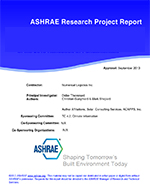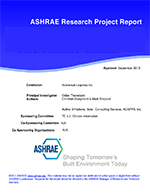Track: HVAC&R Systems and Equipment
Sponsor: 5.10 Kitchen Ventilation
Chair: Donald Fisher, P.Eng., Life Member, Fisher Consultants, Danville, CA
The energy intensity and utility costs associated with operating a commercial kitchen ventilation (CKV) system are well recognized within the HVAC design community. However, there is no piece of equipment that generates more controversy within the foodservice industry than the exhaust hood, in all its styles and makeup-air combinations. There are opportunities to dramatically reduce the amount of energy (and water) consumed by the kitchen ventilation and HVAC systems through optimization and application of emerging technologies.
1. The Potential for Exhaust Air Heat Recovery in Commercial Kitchen Ventilation
Rich Swierczyna, Associate Member, Fisher-Nickel, San Ramon, CA
Thermodynamically, the application of heat recovery to kitchen exhaust air is very attractive to design engineers and foodservice facility managers. Exhaust air temperatures are significantly higher than space conditions (due to heat load from the cooking equipment) and the makeup air heating loads are recognized as a major energy end use within foodservice facilities. Because of the recent advances in commercial kitchen ventilation, the potential for heat recovery is more viable than ever before. This seminar presents the potential for energy recovery and the technologies that have recently taken advantage of the opportunities for heat recovery in commercial kitchens.
2. Field Test Results of an Air-to-Water Heat Exchanger in a Commercial Kitchen
Michael Watz Jr., P.E., Member, Accurex a Greenheck Company, Schofield, WI
This seminar discusses the results of the application of commercial kitchen hood grease filters with integral air to water heat exchangers. Topics in this seminar include a system overview, recommended applications, energy advantages and grease extraction and hood system cleaning advantages.
3. Clean in Place Hoods, the Labor and Water Resource Trade Off
Russell Robinson, Member, Gaylord Industries, Tualatin, OR
Utilizing various technologies, today’s Clean In Place hoods reduce water consumption while providing labor savings and increased employee safety but at what cost? With rising minimum wages, increasing labor and utility costs, does a compelling business model exist to offset the initial capital and long term investment? This presentation focuses on validating the variable costs.
4. Modeling Demand Controlled Kitchen Ventilation Systems
Vernon Smith, P.E., Life Member, Smith Energy Engineers, LLC, Niwot, CO
DCKV systems are becoming more popular as food service designers strive to achieve higher energy savings. However, DCKV systems can be a challenge for energy modelers due to unknowns with expected system operation and lack of features in modeling software. For example, varying the rate of exhaust and makeup air in relation to cooking process heat, smoke, or vapor load is not explicitly modeled in available software. This presentation highlights modeling methodology for three popular energy modeling software packages and provide tips for work-arounds.
Presented: June 26, 2017, 11:00 AM-12:00 PM
Run Time: 60 min.
This is a zip file that consists of PowerPoint slides synchronized with the audio-recording of the speaker (recorded presentation), PDF files of the slides, and audio only (mp3) for each presentation.
Citation: ASHRAE Seminar Recordings, 2017 ASHRAE Annual Conference, Long Beach , CA
Product Details
- Published:
- 2017
- Units of Measure:
- Dual
- File Size:
- 1 file , 73 MB
- Product Code(s):
- D-LB17Sem28


